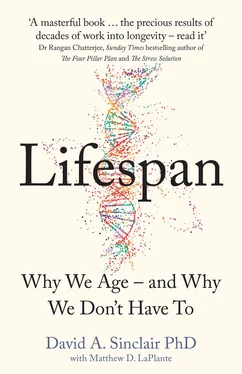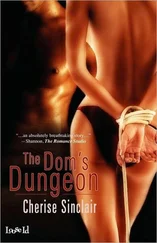This, I believe, is possible.
A TIME TO EVERY PURPOSE
The Information Theory of Aging starts with the primordial survival circuit we inherited from our distant ancestors.
Over time, as you might expect, the circuit has evolved. Mammals, for instance, don’t have just a couple of genes that create a survival circuit, such as those that first appeared in M. superstes . Scientists have found more than two dozen of them within our genome. Most of my colleagues call these “longevity genes” because they have demonstrated the ability to extend both average and maximum lifespans in many organisms. But these genes don’t just make life longer, they make it healthier, which is why they can also be thought of as “vitality genes.”
Together, these genes form a surveillance network within our bodies, communicating with one another between cells and between organs by releasing proteins and chemicals into the bloodstream, monitoring and responding to what we eat, how much we exercise, and what time of day it is. They tell us to hunker down when the going gets tough, and they tell us to grow fast and reproduce fast when the going gets easier.
And now that we know these genes are there and what many of them do, scientific discovery has given us an opportunity to explore and exploit them; to imagine their potential; to push them to work for us in different ways. Using molecules both natural and novel, using technology both simple and complex, using wisdom both new and old, we can read them, turn them up and down, and even change them altogether.
The longevity genes I work on are called “sirtuins,” named after the yeast SIR2 gene, the first one to be discovered. There are seven sirtuins in mammals, SIRT1 to SIRT7 , and they are made by almost every cell in the body. When I started my research, sirtuins were barely on the scientific radar. Now this family of genes is at the forefront of medical research and drug development.
Descended from gene B in M. superstes , sirtuins are enzymes that remove acetyl tags from histones and other proteins and, by doing so, change the packaging of the DNA, turning genes off and on when needed. These critical epigenetic regulators sit at the very top of cellular control systems, controlling our reproduction and our DNA repair. After a few billion years of advancement since the days of yeast, they have evolved to control our health, our fitness, and our very survival. They have also evolved to require a molecule called nicotinamide adenine dinucleotide, or NAD. As we will see later, the loss of NAD as we age, and the resulting decline in sirtuin activity, is thought to be a primary reason our bodies develop diseases when we are old but not when we are young.
Trading reproduction for repair, the sirtuins order our bodies to “buckle down” in times of stress and protect us against the major diseases of aging: diabetes and heart disease, Alzheimer’s disease and osteoporosis, even cancer. They mute the chronic, overactive inflammation that drives diseases such as atherosclerosis, metabolic disorders, ulcerative colitis, arthritis, and asthma. They prevent cell death and boost mitochondria, the power packs of the cell. They go to battle with muscle wasting, osteoporosis, and macular degeneration. In studies on mice, activating the sirtuins can improve DNA repair, boost memory, increase exercise endurance, and help the mice stay thin, regardless of what they eat. These are not wild guesses as to their power; scientists have established all of this in peer-reviewed studies published in journals such as Nature , Cell , and Science .
And in no small measure, because sirtuins do all of this based on a rather simple program—the wondrous gene B in the survival circuit—they’re turning out to be more amenable to manipulation than many other longevity genes. They are, it would appear, one of the first dominos in the magnificent Rube Goldberg machine of life, the key to understanding how our genetic material protects itself during times of adversity, allowing life to persist and thrive for billions of years.
Sirtuins aren’t the only longevity genes. Two other very well studied sets of genes perform similar roles, which also have been proven to be manipulable in ways that can offer longer and healthier lives.
One of these is called target of rapamycin, or TOR, a complex of proteins that regulates growth and metabolism. Like sirtuins, scientists have found TOR—called mTOR in mammals—in every organism in which they’ve looked for it. Like that of sirtuins, mTOR activity is exquisitely regulated by nutrients. And like the sirtuins, mTOR can signal cells in stress to hunker down and improve survival by boosting such activities as DNA repair, reducing inflammation caused by senescent cells, and, perhaps its most important function, digesting old proteins. 43
When all is well and fine, TOR is a master driver of cell growth. It senses the amount of amino acids that is available and dictates how much protein is created in response. When it is inhibited, though, it forces cells to hunker down, dividing less and reusing old cellular components to maintain energy and extend survival—sort of like going to the junkyard to find parts with which to fix up an old car rather than buying a new one, a process called autophagy. When our ancestors were unsuccessful in bringing down a woolly mammoth and had to survive on meager rations of protein, it was the shutting down of mTOR that permitted them to survive.
The other pathway is a metabolic control enzyme known as AMPK, which evolved to respond to low energy levels. It has also been highly conserved among species and, as with sirtuins and TOR, we have learned a lot about how to control it.
These defense systems are all activated in response to biological stress. Clearly, some stresses are simply too great to overcome—step on a snail, and its days are over. Acute trauma and uncontrollable infections will kill an organism without aging that organism. Sometimes the stress inside a cell, such as a multitude of DNA breaks, is too much to handle. Even if the cell is able to repair the breaks in the short term without leaving mutations, there is information loss at the epigenetic level.
Here’s the important point: there are plenty of stressors that will activate longevity genes without damaging the cell, including certain types of exercise, intermittent fasting, low-protein diets, and exposure to hot and cold temperatures (I discuss this in chapter 4). That’s called hormesis. 44Hormesis is generally good for organisms, especially when it can be induced without causing any lasting damage. When hormesis happens, all is well. And, in fact, all is better than well, because the little bit of stress that occurs when the genes are activated prompts the rest of the system to hunker down, to conserve, to survive a little longer. That’s the start of longevity.
Complementing these approaches are hormesis-mimicking molecules. Drugs in development and at least two drugs on the market can turn on the body’s defenses without creating any damage. It’s like making a prank call to the Pentagon. The troops and the Army Corps of Engineers are sent out, but there’s no war. In this way, we can mimic the benefits of exercise and intermittent fasting with a single pill (I discuss this in chapter 5).
Our ability to control all of these genetic pathways will fundamentally transform medicine and the shape of our everyday lives. Indeed, it will change the way we define our species.
And yes, I realize how that sounds. So let me explain why.
ON APRIL 15, 2003, NEWSPAPERS, TELEVISION PROGRAMS, AND WEBSITESaround the world carried the story: the mapping of the human genome was complete.
Читать дальше












